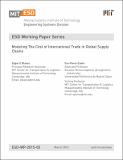| dc.description.abstract | In a global economy, international trade plays an important role of the economic development. This is especially relevant in emerging markets, where trade could contribute significantly to the economic growth of the country. Many studies have pointed out the relationship between logistics performance and the volume of bilateral trade. Limão and Venables (2001) analyze transport costs, Hummels (2001) analyzes transport time and Hausman et al. (2013) evaluate the impact of specific improvements in logistics performance in terms of time, cost and reliability (variability in time) on increased trade.
International Trade ads complexity as goods move across borders where are subject to import and export activities that increase lead times and variability on financial and physical flows (e.g. more documents per trade transaction, more signatures per trade transaction, export clearance, and customs inspection). Also, these global supply chains often involve more actors and agencies that support the trade process such as inspection agencies and custom brokers. Surveys aimed at calculating these costs suggest that they may range from 2% to 15% of the value of traded goods.
This paper provides a general framework to model the impact of international trade of a global supply chain. A cost function is proposed for the buyer, the seller and the upstream suppliers that explicitly refers to the additional elements of international trade. The model is applied to compare the impact of different Incoterms rules (see section 3.2.1) in an International Trade taking into account the total cost of the supply chain Blanco, E.E. and Ponce-Cueto, E. – MIT Center for Transportation & Logistics – March 2015 2 for the main actors, including the buyer (importer) and the seller (exporter).
The paper is organized as follows. Section 2 includes a succinct literature review of relevant papers in global trade management, and more specifically a review of those papers that focus on the total cost in global supply chains. Section 3 defines the global supply chain under study and presents the key events in a global trade. A total global trade function is formulated in Section 4, one function cost for buyers and another for upstream sellers. In section 5 the supply chain costs under various trade scenarios are presented and a numerical example is developed in order to illustrate the applicability of the model. Discussion and conclusion are included in section 6. | en_US |
